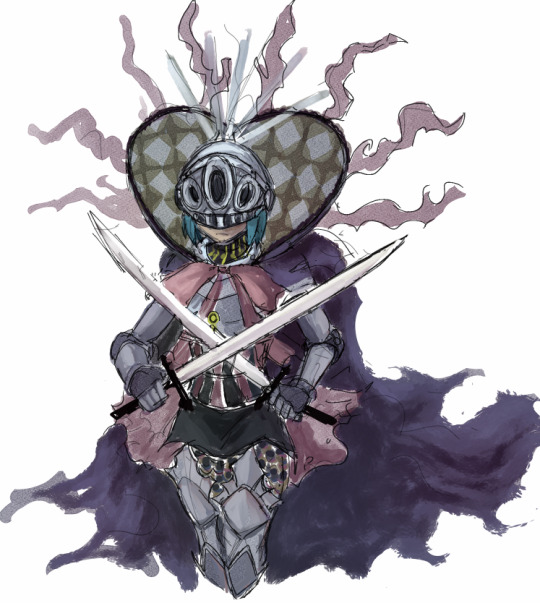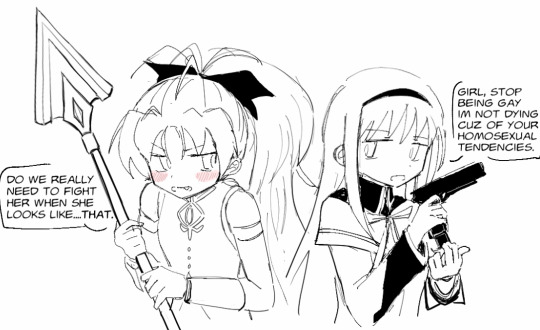Don't wanna be here? Send us removal request.
Text



Extra:

Oktavia sayaka knight concept i had in my brain
a timeline where witches could use their former magical girl bodies still but their personalities are still altered
1K notes
·
View notes
Text








PLANT DAUGHTER PLANT DAUGHTER PLANT DAUGHTER
45 notes
·
View notes
Text
Definitions and Classifications of Yuri (Third Revision) - yuri315
(This is a translation of a 2018 blog post by the user yuri315 on hatenablog, originally found here. I find this author's system incredibly thorough and interesting, as well as the examples they provide of most of the relationship types, so I wanted to translate it and share it with other yuri fans on Tumblr. I included notes on important information that I thought required additional context, and provided links to all of the manga and anime mentioned, in English when possible and in Japanese when no English was available.)
At present, in order to roughly group together a great variety of relationships as "yuri", the question of where the line is on what can be considered yuri, whether a certain work can be called yuri, and other such unproductive arguments happen frequently. The purpose of this article is to create a general classification of the contents of yuri as a genre, in hopes of shifting the conversation from "is this yuri?" to "what kind of yuri do I enjoy?"
Of course, it can't be denied that the ambiguity of the definition of yuri, combining works following a variety of tastes and trends into a single genre, has been an aspect of the boom that's revitalized the genre. Understandably, there are concerns that clumsily subdividing the classification of yuri will cause a lack of cohesion and lead to the boom stalling and collapsing, when as it is now it hasn't even received a genre code at Comiket.* However, for the general public and new fans who don't share these assumptions, it may be difficult for them to understand situations where it isn't clear whether something is yuri, and they may not be influenced or restricted by those saying "X isn't yuri." Therefore, it is the author's belief that it would be significant for the yuri genre to have some form of comprehensive definition or classification.
Let's start with a provisional definition of yuri. Yuri can be described as "relationships between two or more women, and the genre of works that depicts those relationships." By analyzing what feelings and behaviors these "relationships" are based on, the contents of the yuri genre can be classified. In the following article, we will divide yuri into three broad categories: "Romantic Relationships", "Special Relationships" and "Friendly Relationships", and then establish a more detailed typology of how these relationships form and how they may be portrayed in each category. These designations are for convenience only, and the author is currently experimenting to find a better system.
(*TL note: Genre codes at Comiket—Comic Market, a doujinshi convention and the largest fan convention in the world—are used for attending artists/circles to categorize their work. Circles exhibiting works in the same genre code are grouped together in the convention space; there are currently no genre codes for yuri like there are for BL, even now, five years after this article was written.)
1. Romantic Relationships
Romantic and/or sexual relationships between women. This category includes relationships where there is a clear declaration of romantic love, or the relationship can be clearly understood to be romantic despite a lack of an explicit declaration.
1-1. Escape and Compensation
The story depicts indulging in a homosexual relationship as a compensatory act in order for a woman to escape, temporarily or permanently, from a situation in which her right to self-determination is threatened by coercive heterosexuality, such as arranged or forced marriages or betrothals.
1-2. Temptation and Conflict
The story depicts a woman being seduced into a homosexual relationship by another attractive woman, despite the conflict of their "forbidden love." The seducer is typically portrayed as leading the protagonist into an unknown world, often with tragic consequences. This is nearly synonymous with the "Crimson Rose and Candy" archetype defined by Yukari Fujimoto.* *(TL Note: "Crimson Rose and Candy" is an extremely prevalent archetype in early yuri, originally depicted in Shiroi Heya no Futari, what is generally considered the first yuri manga. Despite its origins and association with yuri, due to the overlap in the genres and authors in the Year 24 Group, it's an archetype that was present in contemporary M/F shoujo and BL, notably Gilbert and Serge in Kaze to Ki no Uta.)
1-3. Self-Awareness and Confession
The story depicts adolescent girls becoming self-aware of their feelings and fluctuations in their sexuality, and, through confessing, beginning romantic relationships. Coming-of-age stories in school settings where the girls face problems particular to puberty are especially common. Examples: - Akira Okudaira x Fumi Manjome (Sweet Blue Flowers by Takako Shimura) - Mariko Kumakura x Akiko Oohashi (GIRL FRIENDS by Milk Morinaga) - Tsubaki Kureha x Ginko Yurishiro (Yurikuma Arashi)
1-4. Negotiation and Dialog
The story depicts a romantic relationship between women who are equal individuals. They are typically emotionally mature to some degree, and already aware of their own sexuality. Negotiations between them occur as necessary as the relationship progresses, and if problems or obstacles arise, they're resolved through dialog between the characters. Examples: - Momoko Naitou x Shinobu Handa x others (Shoujo Sect by Kenn Kurogane) - Yukino Miyashita x Setsuko Iwai (Octave by Haru Akiyama) - Tsukasa Shiratori x Mikage Kotooka x Nadeshiko Washio (Nameless Asterism by Kina Kobayashi)
1-5. Continuation and Stability
The story depicts women who are already dating or living together as a couple. The focus is on the continuation of an established relationship and its stability into the future, and concerns such as living arrangements or coming out to those around them. Most yuri of this type features working adults, and typically include sex or similar acts. Examples: - Maya Nagumo x Michiru Amamiya (Ohana Holoholo by Shino Torino) - Arisa Suzuki x Mari Satou (Akarui Kioku Soushitsu by Oku Tamamushi)
1-6. One-sided Love
The story depicts one woman having unrequited feelings for another woman. This includes stories where these feelings remain hidden for the entirety of the work, or where she confesses and is rejected. Examples: Tomoyo Daidouji → Sakura Kinomoto (Cardcaptor Sakura)
2. Special Relationships
Relationships where the feelings between the characters are ambiguous but special, and can't be constrained by the definitions of either friendship or love. Regardless of the nature of the relationship, the common point is a sense of awareness that "this person is special to me." In most cases, the relationship isn't explicitly stated to be one of romantic love, but can still be said to be nearly a romantic relationship, or a pseudo-romantic relationship.
2-1. Magnetic Attraction
The story depicts an intense relationship in which the characters mutually resonate with one another on an existential or spiritual level, and are irresistibly and strongly attracted to one another, as if by magnetism or gravity. The invention of the term "magnetic attraction" is the greatest achievement of Sound! Euphonium and can be considered a major event in the world of yuri. Examples: - Kumiko Oumae x Reina Kousaka (Sound! Euphonium) - Ange x Princess (Princess Principal)
2-2. Partners
The story depicts characters who become involved with one another in a half-formed way through fate or various other inevitable circumstances, and later develop a strong physical or emotional bond. It's a similar concept to "Forced Yuri", the tagline of MekiMeki's Only☆You ~Anata to Watashi no Futari Bocchi Keikaku~. Examples: - Haruka Tenou x Michiru Kaiou (Sailor Moon S) - Papika x Cocona (Flip Flappers) - Sara Ayafuji x Iris Kazari (Vampire-chan x Kouhai-chan by Sakaki Yoshioka)
2-3. Shelter
The story depicts a relationship that serves as a refuge from existential anxiety, miscommunication and societal oppression. There are similarities to 1-1 "Escape and Compensation", but instead of simple escapism, this type has the positive connotation of bonds between women facilitating healing, self-examination, and rebuilding one's way of life and relationships with other people in order to grow as a human being. Examples: - Utena Tenjou x Anthy Himemiya (Revolutionary Girl Utena) - Rakka x Reki (Haibane Renmei) - You Aizawa x Hana Kojima (I Want To Make You Cry by Bunbi Bun)
2-4. Buddies
The story depicts a relationship in which the characters act together to achieve a specific goal, and are connected by a strong bond of trust. Unlike 2-2 "Partners", these are often somewhat passive relationships where the characters' partnership is necessary to achieve their objectives, but over time they may realize their importance to each other and prioritize being together. Aside from truly equal "buddies", this can also include asymmetrical relationships like master-and-servant yuri. Examples: - Mireille Bouquet x Kirika Yuumura (NOIR) - Sora Naegino x Layla Hamilton (Kaleido Star) - Arika Yumemiya x Mashiro Blan de Windbloom (My-Otome)
2-5. Huge Unclear Emotions
The story depicts at least one of the women feeling incredibly intense emotions toward another woman. Specifically, there are three main types: evaluative emotions, such as good will, respect, admiration, envy or worship, obsessive emotions, such as possessiveness, protectiveness, dependence, or sadistic or masochistic desire, and hostile emotions, such as rivalry, jealousy, hatred, or a desire to kill. However, various emotions are often intricately interwoven in a way that is difficult to describe in one or two words. Examples: - Mamina x Roatreamon (Simoun) - Madoka Kaname x Homura Akemi (Puella Magi Madoka Magica) - Chariot du Nord x Croix Meridies (Little Witch Academia)
2-6. Closeness
The story depicts a slow awareness of one another in an intimate relationship. It involves the characters feeling safe when they're together, or having the feeling that they belong by one another's side. Examples: - Shino Kishibe x Nozomi Kishibe (I Live With My Brother's Wife. by Kuzushiro)
3. Friendly Relationships
Relationships that aren't particularly special, but are nonetheless amiable and intimate. This can include a huge range of relationships, from deep camaraderie and familial relationships to simple playful friendship between girls.
Of the above, 1. "Romantic Relationships" can be considered "true yuri", while 2. "Special Relationships" and 3. "Friendly Relationships" could be called "soft yuri."
361 notes
·
View notes
Text
9 notes
·
View notes












